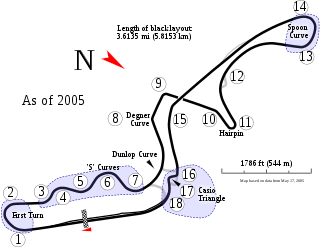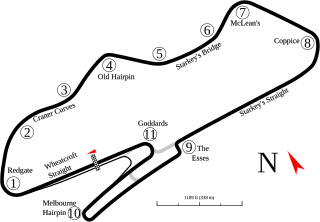
Williams Grand Prix Engineering Limited, currently racing in Formula One as Williams Racing, is a British Formula One team and constructor. It was founded by Sir Frank Williams (1942–2021) and Sir Patrick Head. The team was formed in 1977 after Frank Williams's earlier unsuccessful F1 operation: Frank Williams Racing Cars. The team is based in Grove, Oxfordshire, on a 60-acre (24 ha) site.

Alain Marie Pascal Prost is a French retired racing driver and Formula One team owner. A four-time Formula One World Drivers' Champion, from 1987 until 2001 he held the record for most Grand Prix victories until Michael Schumacher surpassed Prost's total of 51 victories at the 2001 Belgian Grand Prix.

Ayrton Senna da Silva was a Brazilian racing driver who won the Formula One World Drivers' Championship in 1988, 1990, and 1991. One of three Formula One drivers from Brazil to become World Champion, Senna won 41 Grands Prix and set 65 pole positions, with the latter being the record until 2006. He died as a result of an accident while leading the 1994 San Marino Grand Prix, driving for the Williams team.

The Japanese Grand Prix is a motor racing event in the calendar of the Formula One World Championship. Historically, Japan has been one of the last races of the season, and as such the Japanese Grand Prix has been the venue for many title-deciding races, with 13 World Drivers' Champions being crowned over the 36 World Championship Japanese Grands Prix that have been hosted. Japan was the only Asian nation to host a Formula One race until Malaysia joined the calendar in 1999.

Gerhard Berger is an Austrian former Formula One racing driver. He competed in Formula One for 14 seasons, twice finishing 3rd overall in the championship, both times driving for Ferrari. He won ten Grands Prix, achieved 48 podiums, 12 poles and 21 fastest laps.

The San Marino Grand Prix was a Formula One championship race which was run at the Autodromo Internazionale Enzo e Dino Ferrari in the town of Imola, near the Apennine mountains in Italy, between 1981 and 2006. It was named after nearby San Marino as there already was an Italian Grand Prix held at Monza even though the Imola Circuit was in Italy and not within San Marino's own territory. In 1980, when Monza was under refurbishment, the Imola track was used for the 51st Italian Grand Prix.

Sir Ronald Dennis is a British businessman and an Official British Business Ambassador for the United Kingdom. He is best known for his former role as owner, CEO, chairman and founder of McLaren Group. Dennis was removed from his McLaren management roles in 2016 but remained a director of the company and a 25-per-cent shareholder until June 2017, when his 37-year association with the company ended.

The 1990 Japanese Grand Prix was a Formula One motor race held on 21 October 1990 at Suzuka. It was the fifteenth and penultimate race of the 1990 Formula One season. It was the 16th Japanese Grand Prix and the 6th held at Suzuka. The race saw a first-corner collision between World Championship rivals Brazilian driver Ayrton Senna and French driver Alain Prost, the second consecutive year that the World Championship had been decided by a collision between the two at the same track. The collision immediately put both cars out of the race and secured Senna his second World Championship, a reversal of fortunes from the 1989 Japanese Grand Prix, where the collision had secured the championship for Prost.

The 1993 European Grand Prix was a Formula One motor race held on 11 April 1993 at Donington Park. It was the third race of the 1993 FIA Formula One World Championship. The race was contested over 76 laps and was won by Ayrton Senna for the McLaren team, ahead of second-placed Damon Hill and third-placed Alain Prost, both driving for the Williams team.

The 1994 Monaco Grand Prix was a Formula One motor race held on 15 May 1994 at the Circuit de Monaco, Monte Carlo. It was the fourth race of the 1994 Formula One World Championship, and the first following the deaths of Ayrton Senna and Roland Ratzenberger at the San Marino Grand Prix two weeks previously.

The 1993 FIA Formula One World Championship was the 47th season of FIA Formula One motor racing. It featured the 1993 Formula One World Championship for Drivers and the 1993 Formula One World Championship for Constructors, which were contested concurrently over a sixteen-race series that commenced on 14 March and ended on 7 November. Alain Prost won his fourth and final Drivers' Championship. As of 2023, this is the last championship for a French Formula One driver.

Stefan Nils Edwin Johansson is a Swedish racing driver who drove in Formula One for both Ferrari and McLaren, among other teams. Since leaving Formula One he has won the 1997 24 Hours of Le Mans and raced in a number of categories, including CART, various kinds of Sports car racing and Grand Prix Masters.

The 1994 San Marino Grand Prix was a Formula One motor race held on 1 May 1994 at the Autodromo Enzo e Dino Ferrari, located in Imola, Italy. It was the third race of the 1994 Formula One World Championship. Michael Schumacher, driving for Benetton, won the race. Nicola Larini, driving for Ferrari, scored the first points of his career when he finished in second position. Mika Häkkinen finished third in a McLaren.

The McLaren MP4/5, and its derived sister model, the McLaren MP4/5B, were highly successful Formula One racing cars designed by the McLaren Formula One team based in Woking, England, and powered by Honda's naturally-aspirated RA109E and RA100E V10 engines respectively. The chassis design was led by Neil Oatley, teaming up with Steve Nichols, Pete Weismann, Tim Wright, Bob Bell and Mike Gascoyne. As with the previous designs, Gordon Murray, as Technical Director, had the role of liaising between the drawing office and production. Osamu Goto was the Honda F1 team chief designer for the car's engine.

The McLaren MP4/8 was the Formula One car with which the McLaren team competed in the 1993 Formula One World Championship. The car was designed by Neil Oatley around advanced electronics technology including a semi-automatic transmission, active suspension, two-way telemetry, and traction control systems, that were developed in conjunction with McLaren shareholder Techniques d'Avant Garde (TAG). It was powered by the 3.5-litre Ford HBD7 V8 engine and was the first McLaren to feature barge boards. The McLaren MP4/8 was also first Ford-powered McLaren car since McLaren MP4/1C in 1983.
On 1 May 1994, Brazilian Formula One driver Ayrton Senna was killed after his car crashed into a concrete barrier while he was leading the 1994 San Marino Grand Prix at the Imola Circuit in Italy. The previous day, Austrian driver Roland Ratzenberger had died when his car crashed during qualification for the race. Several other collisions took place that weekend, including a serious one involving Rubens Barrichello. Ratzenberger and Senna's crashes were the first fatal accidents to occur during a Formula One race meeting since that of Riccardo Paletti at the 1982 Canadian Grand Prix, and were also the last until that of Jules Bianchi at the 2014 Japanese Grand Prix. This became a turning point in the safety of Formula One, prompting the implementation of new safety measures in both Formula One and the circuit, as well as the Grand Prix Drivers' Association to be reestablished. The Supreme Court of Cassation of Italy ruled that mechanical failure was the cause of the crash.

The Williams FW34 was a Formula One racing car designed by Williams F1 for the 2012 Formula One season.

The McLaren MP4-29 was a Formula One racing car designed and built by McLaren to compete in the 2014 Formula One season. The chassis was designed by Tim Goss, Neil Oatley, Matt Morris, Mark Ingham and Marcin Budkowski and was powered by a customer Mercedes-Benz powertrain. The car was unveiled on 24 January 2014, and was driven by 2009 World Drivers' Champion Jenson Button and debutant Kevin Magnussen, who replaced Sergio Pérez, after he won the 2013 Formula Renault 3.5 Series title.

1 is a 2013 documentary film directed by Paul Crowder and narrated by Michael Fassbender. The film traces the history of Formula One auto racing from its early years, in which some seasons had multiple fatalities, to the 1994 death of Ayrton Senna, the sport's most recent death at the time of production. Extensive and often rare archival footage is used throughout.

The Prost–Senna rivalry was a Formula One rivalry between French driver Alain Prost and Brazilian driver Ayrton Senna. The rivalry was at its most intense during the period in which they were teammates at McLaren-Honda in the 1988 and the 1989 seasons, and continued when Prost joined Ferrari in 1990. The relationship between the drivers was viewed by commentators as polarising and fierce, with confrontations between the drivers a regular occurrence.





















